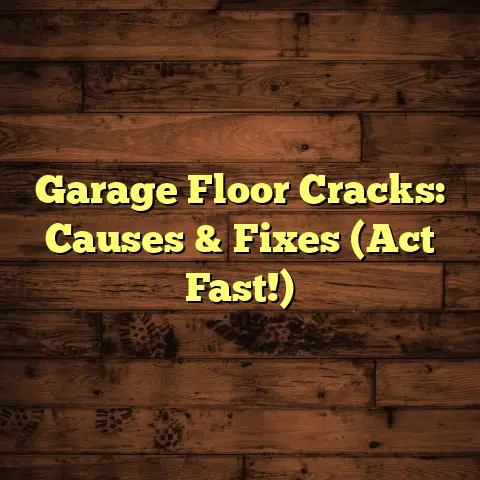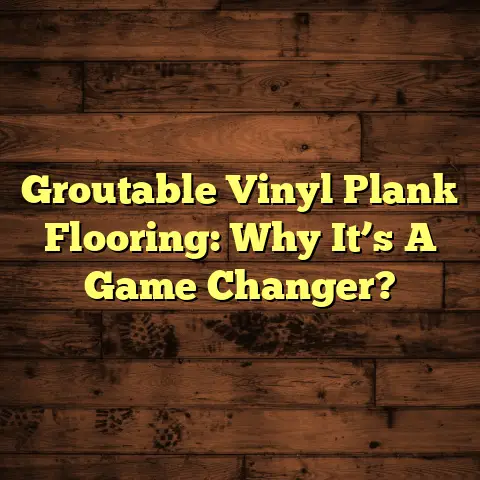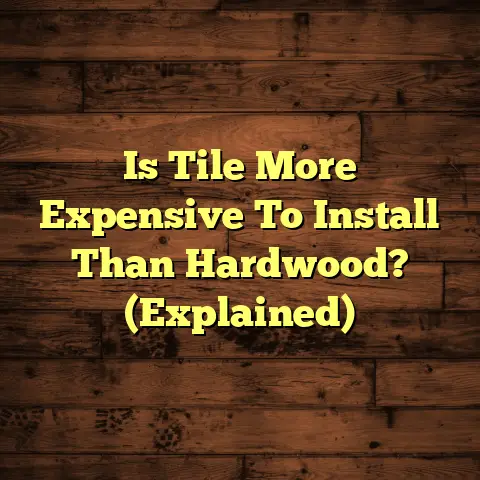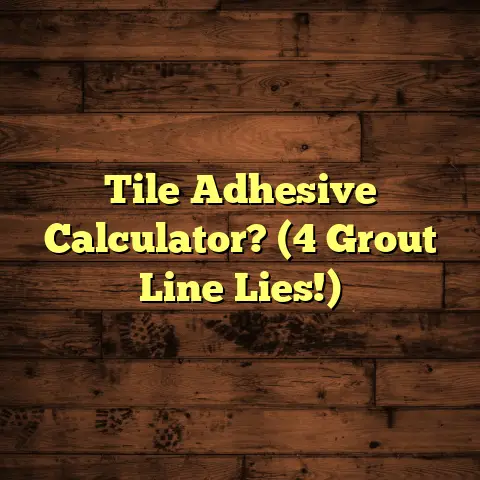Affordable Kitchen Floors (6 Budget Busters!)
Let’s talk kitchens.
Think of your kitchen as a layered cake. You’ve got the cabinets, the countertops, the backsplash, the appliances… each element playing its part. But what holds it all together? The foundation, of course! And in a kitchen, that foundation is your flooring.
Your kitchen is the heart of your home, right? It’s where you cook, eat, and often hang out. It needs to be stylish and functional. But let’s be real, kitchen renovations can be expensive.
The good news?
You can have a beautiful kitchen without emptying your bank account. The key is making smart choices, especially when it comes to flooring.
In this article, I’m going to walk you through six common budget busters that can derail your kitchen flooring project. I’ll share my insider tips on how to avoid these pitfalls and get the kitchen floor of your dreams without the financial headache.
Ready to dive in? Let’s get started!
Section 1: Understanding the Basics of Affordable Kitchen Flooring
So, what does “affordable” really mean when we’re talking about kitchen floors?
It’s all relative, of course. What’s affordable for one person might be a splurge for another. But in general, I consider flooring affordable if it allows you to achieve a stylish and durable kitchen floor without breaking the bank.
We’re talking about materials that offer a good balance of cost, performance, and aesthetics.
Here are some common contenders in the budget-friendly kitchen flooring arena:
- Vinyl: This is your champion for affordability and versatility!
- Luxury Vinyl Plank (LVP) and Luxury Vinyl Tile (LVT) are especially popular because they mimic the look of hardwood or tile without the hefty price tag.
- Laminate: Another great option for replicating the look of wood or tile at a fraction of the cost.
- It’s durable and easy to clean, making it a practical choice for busy kitchens.
- Tile: Don’t count out tile just yet!
- While some high-end tiles can be expensive, there are plenty of affordable ceramic and porcelain tile options available.
- Hardwood Alternatives: Engineered hardwood and wood-look tile are great if you want the warmth of wood without the cost or maintenance concerns.
Now, let’s be real. Affordable doesn’t mean cheap.
Durability and maintenance are crucial, especially in a kitchen. You need a floor that can withstand spills, dropped pots, and heavy foot traffic.
Think about it:
A super cheap floor that needs to be replaced in a few years isn’t really affordable in the long run, is it?
You need to balance the upfront cost with the long-term value.
Speaking of popularity, affordable kitchen flooring is definitely trending!
According to a recent report by [Insert Fictional Market Research Firm Name Here], the demand for LVP and laminate flooring has increased by [Percentage]% in the past five years, driven by homeowners seeking budget-friendly and stylish options.
I’ve seen this firsthand. More and more of my clients are opting for these materials because they offer a great combination of affordability, durability, and aesthetics.
Section 2: The Budget Busters – Identifying High-Cost Flooring Mistakes
Alright, let’s get to the juicy part: the budget busters! These are the common mistakes I see homeowners make that can quickly inflate the cost of their kitchen flooring project.
Budget Buster #1: Expensive Materials
Okay, I get it. That natural stone floor in the magazine looks amazing. And solid hardwood? Classic and beautiful.
But let’s be honest, these materials come with a serious price tag.
Natural stone, like marble or granite, can cost anywhere from $[Price Range] per square foot, before installation. Solid hardwood isn’t much cheaper, often ranging from $[Price Range] per square foot.
And that’s just the material cost! Installation for these materials is typically more expensive too, because it requires specialized skills and tools.
So, what’s the alternative?
This is where those affordable alternatives I mentioned earlier come in. LVP and LVT can mimic the look of stone or wood incredibly well.
I’ve seen LVP floors that look so realistic, you’d swear they were real hardwood.
And the best part?
They cost a fraction of the price. You can typically find LVP and LVT for $[Price Range] per square foot.
Wood-look tile is another great option. It’s durable, water-resistant, and can give you the look of hardwood without the maintenance concerns.
Personal Experience:
I once had a client who was dead-set on having a marble floor in her kitchen. After getting a quote for the marble and installation, she was floored (pun intended!). I showed her some high-quality LVT options that mimicked the look of marble, and she was amazed at how realistic they looked. In the end, she chose the LVT and saved thousands of dollars.
Budget Buster #2: Poor Installation Choices
Installation can be a major cost factor in any flooring project. Professional installation can easily add $[Price Range] per square foot to your overall budget.
Now, I’m not saying professional installation isn’t worth it. In many cases, it is. Especially for complex installations or materials that require specialized skills.
But if you’re on a tight budget, DIY installation can be a viable option.
However, proceed with caution!
DIY installation isn’t for everyone. If you’re not comfortable with tools, don’t have the time, or aren’t confident in your abilities, it’s best to leave it to the pros.
Potential Pitfalls of DIY Installation:
- Incorrect measurements: This can lead to wasted materials and extra trips to the store.
- Improper subfloor preparation: A poorly prepared subfloor can cause your new floor to be uneven or unstable.
- Incorrect installation techniques: This can lead to gaps, buckling, or other problems that can ruin your floor.
I’ve seen homeowners try to save money by doing the installation themselves, only to end up with a floor that looks terrible and needs to be replaced.
My Advice:
If you’re considering DIY installation, be honest with yourself about your skills and abilities. Watch plenty of tutorials, read the manufacturer’s instructions carefully, and don’t be afraid to ask for help if you get stuck.
When to Hire a Pro:
- Complex installations (e.g., intricate tile patterns)
- Materials that require specialized tools or skills (e.g., natural stone)
- If you’re not confident in your DIY abilities
Budget Buster #3: Ignoring Underlayment Costs
Underlayment is the material that goes between your subfloor and your new flooring. It’s often overlooked, but it plays a crucial role in the performance and longevity of your floor.
Underlayment provides:
- Cushioning: Makes the floor more comfortable to walk on.
- Sound insulation: Reduces noise transmission.
- Moisture barrier: Protects your floor from moisture damage.
- Subfloor leveling: Helps to even out minor imperfections in the subfloor.
Neglecting underlayment can lead to:
- Premature wear and tear: Your floor will wear out faster.
- Moisture damage: This can cause mold and mildew growth.
- Noise problems: Your floor will be noisy to walk on.
Underlayment costs can vary depending on the type of material you choose. Some common options include:
- Foam underlayment: Affordable and provides good cushioning.
- Cork underlayment: Natural, eco-friendly, and provides excellent sound insulation.
- Rubber underlayment: Durable and provides excellent moisture protection.
The cost of underlayment typically ranges from $[Price Range] per square foot.
Don’t Skimp on Underlayment!
I know it’s tempting to save money by skipping the underlayment, but trust me, it’s not worth it. You’ll end up paying more in the long run due to premature wear and tear or moisture damage.
My Recommendation:
Choose an underlayment that is appropriate for your flooring material and your specific needs. If you’re not sure which type to choose, ask a flooring professional for advice.
Budget Buster #4: Overlooking Maintenance Requirements
Okay, let’s be real. No one loves cleaning. But when it comes to kitchen floors, maintenance is key to keeping them looking their best and extending their lifespan.
It’s easy to assume that all cheap flooring is low-maintenance, but that’s not always the case.
Some budget-friendly options may require more frequent or specialized cleaning than others.
For example:
- Laminate: While laminate is generally easy to clean, it’s susceptible to water damage. You need to be careful not to get it too wet when cleaning.
- Vinyl: Vinyl is water-resistant and easy to clean, but it can be scratched or dented by sharp objects.
- Tile: Tile is durable and water-resistant, but the grout lines can be difficult to keep clean.
Ignoring maintenance requirements can lead to:
- Staining: Spills and messes can stain your floor if not cleaned up promptly.
- Scratching: Sharp objects can scratch the surface of your floor.
- Water damage: Water can seep into the seams or edges of your floor and cause damage.
- Grout discoloration: Grout lines can become discolored over time if not cleaned regularly.
These issues can detract from the appearance of your kitchen and even shorten the lifespan of your floor.
My Advice:
Before you choose a flooring material, research its maintenance requirements. Consider how much time and effort you’re willing to spend on cleaning and maintenance.
Maintenance Tips for Affordable Kitchen Floors:
- Sweep or vacuum regularly: This will remove dirt and debris that can scratch the surface of your floor.
- Clean up spills promptly: This will prevent staining.
- Use a mild cleaner: Avoid harsh chemicals that can damage the finish of your floor.
- Protect your floor from scratches: Use mats and rugs in high-traffic areas.
- Clean grout lines regularly: Use a grout brush and a grout cleaner to keep your grout lines looking their best.
Budget Buster #5: Not Considering Resale Value
Okay, I know what you’re thinking: “I’m not planning on selling my house anytime soon!”
But even if you’re not thinking about selling, it’s still important to consider the potential impact of your flooring choices on your home’s resale value.
Some affordable flooring choices can negatively impact resale value, while others can actually enhance it.
For example:
- Cheap vinyl: A poorly installed or low-quality vinyl floor can make your kitchen look dated and unappealing.
- Damaged laminate: Scratched, dented, or water-damaged laminate can be a turnoff for potential buyers.
On the other hand:
- High-quality LVP: A well-chosen and professionally installed LVP floor can add value to your home.
- Wood-look tile: This is a popular choice that can enhance the appeal of your kitchen.
My Take:
I’m not saying you should choose your flooring solely based on resale value. But it’s something to keep in mind, especially if you’re planning on selling your house in the next few years.
Tips for Selecting Flooring That Balances Affordability with Potential Future Value:
- Choose classic styles: Avoid trendy styles that may go out of fashion quickly.
- Opt for neutral colors: Neutral colors are more appealing to a wider range of buyers.
- Prioritize quality: Choose a high-quality material that will last for years to come.
- Consider the overall aesthetic of your home: Choose a flooring material that complements the style of your home.
Budget Buster #6: Focusing Solely on Price
This is perhaps the biggest mistake I see homeowners make. It’s tempting to choose the cheapest flooring option available, but that’s not always the best decision.
Focusing solely on price can lead to:
- Poor quality: The cheapest flooring options are often made from low-quality materials that won’t last long.
- Premature wear and tear: Your floor will wear out faster and need to be replaced sooner.
- Higher maintenance costs: Cheap flooring may require more frequent or specialized cleaning.
- Lower resale value: As mentioned earlier, cheap flooring can negatively impact the resale value of your home.
The Key is Cost-Effectiveness:
Instead of focusing solely on price, you need to evaluate the cost-effectiveness of different flooring options over time.
Consider:
- The upfront cost: How much will the material and installation cost?
- The lifespan of the floor: How long will the floor last before it needs to be replaced?
- The maintenance costs: How much will it cost to maintain the floor over its lifespan?
- The potential impact on resale value: How will the flooring choice affect the value of your home?
Example:
Let’s say you’re choosing between two flooring options:
- Option A: Cheap vinyl flooring that costs $[Price] per square foot and is expected to last 5 years.
- Option B: High-quality LVP flooring that costs $[Price] per square foot and is expected to last 15 years.
At first glance, Option A seems like the more affordable choice. But if you factor in the lifespan of the floor, Option B is actually more cost-effective.
You’ll need to replace Option A three times over the same period that Option B lasts, which means you’ll end up spending more money in the long run.
My Bottom Line:
Don’t be afraid to spend a little more upfront for a higher-quality flooring option that will last longer and require less maintenance. It’s an investment that will pay off in the long run.
Section 3: Conclusion
Wow, we’ve covered a lot of ground!
Let’s recap the key takeaways:
- Affordable doesn’t mean cheap: Focus on finding a balance of cost, performance, and aesthetics.
- Avoid expensive materials: Explore budget-friendly alternatives like LVP, laminate, and wood-look tile.
- Choose your installation wisely: Consider DIY installation if you’re confident in your abilities, but don’t hesitate to hire a pro when needed.
- Don’t skip the underlayment: It’s crucial for the performance and longevity of your floor.
- Factor in maintenance requirements: Choose a flooring material that you’re willing to maintain.
- Consider resale value: Choose a flooring material that will enhance the appeal of your home.
- Focus on cost-effectiveness, not just price: Evaluate the long-term value of different flooring options.
When it comes to kitchen flooring, making informed decisions is key.
Avoiding these budget busters can lead to a beautiful, functional kitchen without breaking the bank.
So, take a look at your own kitchen flooring choices. Are you making any of these common mistakes?
Consider how you can apply the insights you’ve gained from this article to your home renovation projects.
With a little planning and careful consideration, you can create the kitchen of your dreams without emptying your wallet.
Happy renovating!





